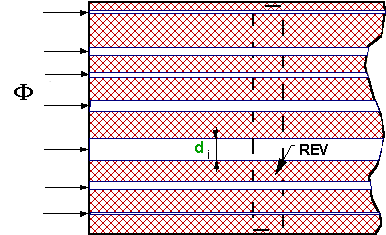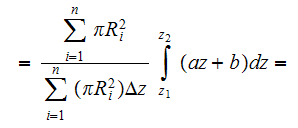
This is the next problem from a classical list we liked to explore to find out the possibilities for the observable understandable solution for the problem within the mutual HSP-VAT content. And at the same time this problem also has been passing to a worker the challenge to figure out - What is the difference between the conductivity in a medium with just one conductive bar in a dielectric matrix and a conductivity coefficient when a bunch of bars distributed in the same dielectric? For the diluted bar distribution we have the long ago known mathematical formulation.
The difference also would be due to the mode (way) formulating the solution as for the bulk medium conductivity. We state that this is the same kind of the two scale problem which needs to be formulated for the both scales, not just for the lower one.
Here is the problem, which for some statements can be solved analytically as well. Few features remind the solution of the Upper scale momentum transport in the three regime capillary porous medium with the straight capillaries in the study by
Travkin, V.S. and Catton, I., "Nonlinear Effects in Multiple Regime Transport of Momentum in Longitudinal Capillary Porous Medium Morphology", J. Porous Media, Vol. 2, No.3, pp. 277-294, 1999. We will try to make parallels between mathematical statements for both problems and between the two scale solutions.

Straight bars or capillaries crossing through the dielectric layer.
Let's consider a two-phase heterogeneous medium consisting of an isotropic
dielectric continuous (solid) matrix and an isotropic discontinuous phase
(bars or capillaries). The volume fraction of matrix, or 1st phase, is



 ,
the volume fraction of filler, or 2nd phase, is
,
the volume fraction of filler, or 2nd phase, is

 ,
where
,
where

 is
the volume of the REV. The constant properties (phase conductivities,
is
the volume of the REV. The constant properties (phase conductivities,

 and
and

 ) control the stationary (time-independent) electric potential field differential
equations for
) control the stationary (time-independent) electric potential field differential
equations for

 and
and

 .
.
If one regards a problem of the electrical potential distribution in a
separate single conductive capillary or tube of circular cross-section in a
bundle of capillaries, when on the one side of the tube is the absolute
conductor with the potential given as

 and on another side of the tube the potential of the cross-section is
and on another side of the tube the potential of the cross-section is

 and when
and when

 >
>

 with
the difference of potentials is
with
the difference of potentials is

 Then the electrostatic potential field
Then the electrostatic potential field

 (
(
 inside of the capillary will comply to the Laplace equation
inside of the capillary will comply to the Laplace equation

inside of the second phase volume

 with the usual simplified boundary conditions
with the usual simplified boundary conditions
 | (1) |
where

 is the wall surface of the capillary, and
is the wall surface of the capillary, and
 | (2) |
where

 and
and

 are the potentials on both sides of medium slab applied that the unit voltage
drop corresponds to the unit length in the primary z-direction described by
unit vector
are the potentials on both sides of medium slab applied that the unit voltage
drop corresponds to the unit length in the primary z-direction described by
unit vector



If there are many capillaries in the slab and they are all directed in z-direction, then the potential drop and the pressure drop if the fluid is moving inside of capillaries are all of the same values

We can treat the model of parallel capillaries or tubes with random diameters.
If capillaries are aligned in the direction of unit vector

 which is the unit vector along of z-coordinate, then the upper scale VAT
conductivity equation for the conductive medium (second phase) of capillaries
which is the unit vector along of z-coordinate, then the upper scale VAT
conductivity equation for the conductive medium (second phase) of capillaries
 | (3) |
which is for one dimension (with constant

 upper scale equation yields the form
upper scale equation yields the form

where

 is the upper scale space coordinate coinciding in direction with the lower
scale space z-axis.
is the upper scale space coordinate coinciding in direction with the lower
scale space z-axis.
Due to 1D spatial character of the upper scale VAT potential function equation it will take the following form in cartesian coordinates of the problem's upper scale space

Adopted boundary conditions (1), (2) bring the lower first scale potential equation to

which is the single attractive feature of this simplified first scale
(conventional) model. The solution for the potential inside of the

 th
capillary will be
th
capillary will be

with the current

Note, that there is no participation of the second phase potential, because
the problem stated as the non-conjugated one. After taking





 for each capillary, one can calculate the average potential variable for
variable one diameter capillary morphology (taking the point
for each capillary, one can calculate the average potential variable for
variable one diameter capillary morphology (taking the point

 of the lower scale coordinate system as the representative point in the upper
scale coordinate system, which has no principal difference for the result)
of the lower scale coordinate system as the representative point in the upper
scale coordinate system, which has no principal difference for the result)




or

which results in calculation of the first term in equation (3)

note that

while the second term in equation (3) also comes to zero (for easier
demonstration take the cylindrical REV

 for the one separate
for the one separate

 -th
capillary, that does not have difference for final result)
-th
capillary, that does not have difference for final result)


That means the upper scale VAT equation for the capillaries medium is satisfied for the regions inside of the layer's boundaries by the function

Obviously, this simple model having the closed analytical solution is of no technological interest. The effective conductivity coefficient for this one-phase medium is

going further one gets using the homogeneous GO theorem (as for the one scale effective conductivity) on the left hand side of this equation

or after rewriting the operators the effective coefficient is equal

where

The result should not be unexpected as long as the physical conditions for the problem were simplified greatly - taken the diluted medium with no presence of the first phase (matrix) phenomena, allowing in this way the single phase modeling and the separate capillaries consideration. The homogeneous coefficient of conductivity and the morphology of the conductive phase secured the conditions well above a percolation threshold.
We might note, that this simplified example has an educational sense as to purportedly demonstrate the connection between scale's supposed problems solutions.
We believe that the complete analytical solution for the lower scale conjugate media electrostatics problem possible for this kind of morphologies (diluted capillaries), as it was done in thermal physics field.
Much more interesting the two-phase congugate problems were considered in works [37,47,53,54] see in -
where the similar morphologies with stochastically choosen diameters of the capillaries, and the variety of pores orientation had been studied using the two-scale HSP-VAT composite media modeling.
The complete numerical solution allowed after solving practically exactly the lower scale transport equations, based on the VAT equations for the lower scale properties and upper scale properties closures were completed for those terms associated with the field's fluctuations and the interface transport. Then, the upper scale VAT equations were simulated with the numerically allowed accuracy. The attractive feature of this morphology is that all parameters and characteristics can be evaluated precisely for both scales using directly the lower scale solutions. While the lower scale equations are rather the conventional, straightforward equations those easily can be solved. This gives to one the ability to develop the hierarchy analysis for transport characteristics depending on morphology characteristics.
And this is the real "Structure-Properties Relations" connection, the exact reflection of direct effect of morphological properties, mathematically recognized for the problem's solution properties.
[37] Travkin, V.S. and Catton, I. Nonlinear Effects in Multiple Regime Transport of Momentum in Longitudinal Capillary Porous Medium Morphology//J. Porous Media. 1999. V.2, N.3. P.277-294.
[47] Travkin, V.S., Hu, K., and Catton, I. Exact Closure of Hierarchical VAT Capillary Thermo-Convective Problem for Turbulent and Laminar Regimes//Proc. Intern. Mech. Engin. Cong. Expo. (IMECE'2001) (New York, IMECE/HTD-24261, 2001). P.1-12.
[53] Hu, K., Travkin, V.S., and Catton, I. Two Scale Hierarchical Network Model of Heat and Momentum Transport in Porous Media//Proc. 35th Nat. Heat Trans. Conf. (2001 NHTC01-11921). (Anaheim, ASME, 2001).
[54] Travkin, V.S., Hu, K., and Catton, I. Statistics of Mathematical Two-Scale Closure of Momentum, Heat and Charge Transport Problem with Stochastic Orientation of Porous Medium Capillaries//Proc. Intern. Mech. Engin. Cong. Expo. (IMECE'2001). (New York, IMECE/HTD-24157, 2001). P.1-12.